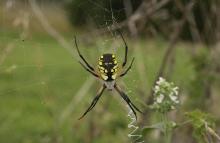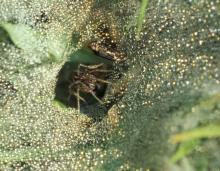Land Invertebrates
Media

Species Types
Scientific Name
Argiope aurantia
Description
The black-and-yellow garden spider is large but harmless. It sets up large, circular webs in gardens and grasslands. Lucky gardeners can host this remarkable pest exterminator all season long.
Media

Species Types
Scientific Name
Verrucosa arenata
Description
In late summer and fall, woodland hikers can count on walking into the arrowhead spider's web. These webs are delicate circles that help the spider snare tiny flying insects.
Media

Species Types
Scientific Name
Micrathena spp.
Description
Missouri has three species of spiny orbweavers in genus Micrathena. The webs of these woodland spiders are often run into by hikers!
Media

Species Types
Scientific Name
Argiope trifasciata
Description
The banded, or white-backed garden spider is slightly smaller than the black-and-yellow garden spider and has a pointier hind end. The abdomen is patterned with many thin silver and yellow transverse lines and thicker black, spotty lines.
Media

Species Types
Scientific Name
Pisaurina spp.
Description
Nursery web spiders build silken tents in plants to protect their egg sacs, then stand guard until the hatchlings are ready to disperse. Large and velvety, nursery web spiders have long legs and variable color patterns.
Media

Species Types
Scientific Name
Agelenopsis spp.
Description
The funnel-shaped web of grass spiders is more often noticed than the spider itself. It is sheetlike, usually positioned horizontally, with a funnel leading downward to a shelter (a rock crevice or dense vegetation) where the spider hides, waiting for prey.
Media

Species Types
Scientific Name
Pholcus, Psilochorus, and others in the Pholcid family
Description
Cellar spiders look wispy with their incredibly long, thin legs and habit of bouncing rapidly in their cobwebs when disturbed, which turns them into a blur. Some species are very common in homes.
Media

Species Types
Scientific Name
About 6,500 species have been named so far, worldwide.
Description
Daddy longlegs, or harvestmen, are familiar Missouri animals. They are not spiders, but opilionids. Unlike spiders, they have a fused body form and lack silk and venom glands.
Media

Species Types
Scientific Name
Tetragnatha spp.
Description
Longjawed orbweavers are called stretch spiders because they rest with their legs stretched straight out in front of and behind their slender bodies. They build their circular webs horizontally, within a few feet above the surface of a stream or lake.
Media

Species Types
Scientific Name
Neriene radiata (formerly Prolinyphia marginata)
Description
The filmy dome spider is one of the most abundant woodland spiders in Missouri. Although the spider is tiny, its snare web, which looks like an upside-down silk bowl, is conspicuous throughout the year.
See Also



Media

Species Types
Scientific Name
Cisseps fulvicollis
Description
The yellow-collared scape moth is more often “orange-collared.” And whether you think it looks more like a firefly or a wasp, it’s still a moth!
Media

Species Types
Scientific Name
Nearly 150 species in North America north of Mexico
Description
Slim, delicate plume moths are instantly recognizable by their T-shaped silhouette, long legs, and muted shades of tan and brown. It can be hard to separate the various species.
Media

Species Types
Scientific Name
Pyrrharctia isabella
Description
Not many people know the adult Isabella tiger moth when they see one, but we’re all acquainted with its caterpillar, the woolly worm, or woolly bear.
About Land Invertebrates in Missouri
Invertebrates are animals without backbones, including earthworms, slugs, snails, and arthropods. Arthropods—invertebrates with “jointed legs” — are a group of invertebrates that includes crayfish, shrimp, millipedes, centipedes, mites, spiders, and insects. There may be as many as 10 million species of insects alive on earth today, and they probably constitute more than 90 percent all animal species.





















